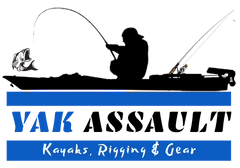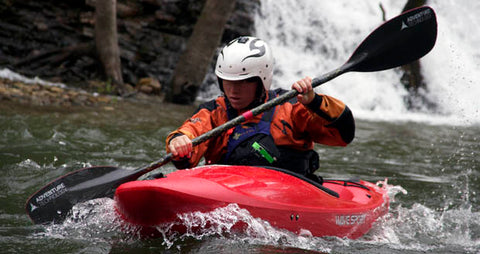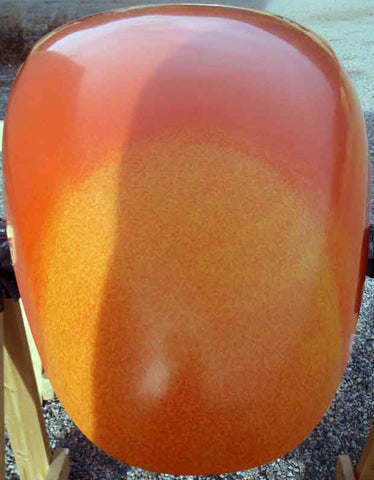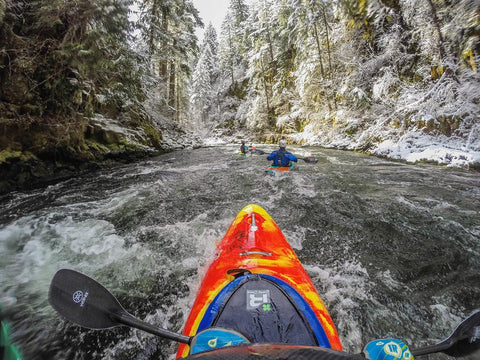Guide to Buying a Whitewater Kayak
So, you want to buy a whitewater kayak. There are several Things to Consider When Buying Your Next Whitewater Kayak.
Even though whitewater kayaking is a small industry, the number of boat choices on the market can feel overwhelming. Luckily, no kayak manufacturer CKS Online carries makes a bad kayak. But, some kayaks will be better or worse for beginners, and choosing appropriately will dramatically better your experience starting out and how you quickly improve.
First, we’ll talk about common features and kayak terms used to differentiate boats.
Next, we’ll look at the different types of whitewater kayaks.
Finally, it is worth considering your goals and learning style to decide what type of kayak will suit you best.
Common terms to understand when buying a kayak
Outfitting
Outfitting is the stuff inside the boat that holds you in. Your seat, backband, thigh hooks, and bulkhead (foot brace) are the main points that hold you into your kayak. Any new kayak will come with a variety of pads to help you make your outfitting fit you well.
While every company makes high quality adjustable outfitting, many seasoned paddlers will have preferences on outfitting based on what feels best to them.
Edges
Where the kayak transitions from the bottom (hull) to the side is referred to as the edge of the kayak. In water, the edge sits just below the kayak’s waterline and plays a large role in how your kayak interacts with the water.
Kayaks can have sharp edges that cut into the water, or soft edges that are more curved and forgiving. Sharp edges allow you to carve across current better, but are less forgiving and allow you to flip easier if your technique is off.
Rocker
Rocker is how much curve the hull of your kayak has from front to back (bow to stern). Rocker helps get the bow of your kayak up and over waves. A banana shaped kayak has a high rocker, while a flat kayak has a low rocker.
Many modern designs have rocker in the bow and stern, and a flatter section in the middle of the boat.
Hull Type
Kayaks traditionally have one of two hull types: Displacement hull or planing hull. A displacement hull is rounded and sits lower in the water. With the soft edges of a displacement hull, you can often feel your boat interact with the water more as it sits deeper in the current. For example, the Pyranha Kayaks Machno has a semi-displacement hull.
A planing hull kayak has a flat shape with sharp edges. They sit higher in the water and are better at cutting across currents. Most kayaks made today have a planing hull, as this high performance design gives you more control in pushy whitewater. Some kayaks still offer a displacement hull or a hybrid of the two because displacement hulls are more forgiving and offer advantages in shallow, rocky rapids. A perfect example of this would be the Jackson Kayak Gnarvana.
Kayak Sizing
Most boats come in different sizes of the same design. When you look at the specs for a kayak, the manufacturer always provides a weight range so paddlers can choose the right size based on their weight.
The volume of a kayak can give you another insight into the size of the boat. While comparing volume is helpful when determining the relative size of a boat, often the way the volume is distributed can have more of an impact.
Manufacturers also publish a width and and length for all kayaks. Wider kayaks are often more stable than narrower kayaks, and shorter kayaks are easier to turn but also slower than longer kayaks.
Types of kayaks
Historically, whitewater kayaks have been split into three categories:
Lately, the term “river runner” is falling out of style, and new designs referred to as “half-slice kayaks” have taken their place in most kayak manufacturer’s line-up.
Creek Boats (Creekers)
Creek Boats are the most forgiving kayaks and are often designed to make hard rapids feel easier. Large volume and softer edges make creek boats perfect for running the steepest, toughest rapids.
They are also a great choice for a beginner who wants to accelerate the learning curve so that they can start feeling comfortable in a kayak as quickly as possible. While a creek boat won’t help quite as much to dial in your technique, a creek boat will help keep you upright and will make rapids that are challenging in other boats feel easier.
One recent trend in creek boats has been to make longer, faster kayaks designed for racing. These designs are usually 9 feet long and are less stable, but faster than traditional creek boats that are usually in the 8’ to 8’10” range.
Playboats/Freestyle
Playboats are the opposite of a creek boat in most ways. These designs are low volume with very sharp edges. These designs make rapids harder but allow you to do tricks as you run rapids or surf waves along the river.
Playboats often come in two styles: Competition Style + Slice Style.
A competition playboat is shorter and more bulbous looking. These are designed for surfing waves or holes and allow for big-air tricks popular for play parks or competitions.
The other style of playboat is referred to as “slicey” or a “full-slice” and features a longer design with a narrow, low-volume bow and stern. The longer shape allows for better river running and the low volume tip and tail promote tricks such as cartwheels or stern stalls where the paddler slices the stern or bow underwater to stand the kayak up on its tail.
Slicey playboats are often inspired by designs of the early 2000s. These have recently become popular – the ‘old school’ designs allow for fun and unique style of paddling.
For many people, a playboat isn’t the best choice for a first kayak because these designs are tough to paddle and lack stability. While it is hard to learn in a playboat, it is not impossible.
For a motivated beginner who doesn’t mind “falling on their face” MANY times, learning in a playboat will ultimately dial in technique and promote habits that will make for a stronger paddler in the long run.
For many kayakers starting out in a playboat, it can take 5 or more days on the water to feel comfortable enough to truly enjoy paddling, while other boats might offer you the same comfort during day one or two.
Half-Slice Kayaks
A half-slice kayak has a high volume bow similar to a creek boat, but a low volume stern similar to a playboat. This combination offers playful feel while maintaining stout downriver performance.
Half-slice boats are usually as long as creek boats and have sharp edges allowing kayakers to carve across current. They are really popular because they feel fun and sporty on almost any river, yet still perform in difficult rapids.
The volume in the front keeps your bow up above waves while the low-volume, “slicey” tail lets you pivot the boat quickly and do tricks such as stern stalls.
For many beginners, a half-slice can make a great first kayak as the sharper edges promote good technique while the high volume bow and longer design provide enough stability to prevent people from becoming too discouraged as they learn.
Goals and learning style
The first step to buying a kayak is determining your whitewater kayaking goals. A paddler who is ready to get on the river 5 days a week, year round will be looking for a very different boat than someone who is looking to get out once or twice a month as they learn.
There is no sugarcoating the fact that kayaking can be a difficult sport to learn, and the first few days in a boat can often be just as frustrating as they are rewarding. Some boats make starting out very difficult but at the same time teach you better technique and give you more room to advance. Other kayaks will make starting out easy – but as you progress, the more forgiving designs can prevent you from honing technique.
If you are the kind of person who doesn’t want to flip over very often, starting out in the most stable design is a good idea. If you don’t mind a steep learning curve involving swimming out of your kayak and rolling over often, starting out in a smaller and less stable kayak will lead to better technique in the long run and will help you progress to harder whitewater.
What boat is best for me?
Over the years, kayaks such as the Liquid Logic Alpha, Pyranha Scorch and the Jackson Zen (first, second generation and third) have all been top choices for beginners, because these designs offer stable and forgiving kayaks that make paddling feel easier.
Recently, newer designs such as the Dagger Code and Jackson Gnarvana have become the go-to options for beginners looking for a creek boat that will take care of them.
With half-slice boats becoming more popular, beginners are often choosing these kayaks because they are better for learning skills such as edge control and they remain a fun choice as kayakers progress to expert-level kayaking.
Kayaks like the Dagger Rewind and Pyranha Ripper 2 are loved by experts and beginners alike as they offer a great combination of features to make paddling fun without making it too difficult.
While a little smaller, the Jackson Antix 2.0 also fits the bill and is a great choice for an enthusiastic beginner.
While playboats aren’t a good choice for most people, those who are willing to be patient and fall a lot before they succeed are rewarded with strong technical skills.
The Dagger Nova and the Pyranha Ozone are good full slice boats for a highly motivated beginner looking to learn technical skills early on in their paddling.
High performance playboats such as the Jackson Rockstar V and the Pyranha Jed are often reserved for paddlers specifically looking to train for freestyle.
CKS Online’s Top Choice(s)
For the casual paddler, we recommend either the Pyranha Scorch or Jackson Gnarvana. Both of these creek boats promote stability and let you enjoy paddling without too steep of a learning curve.
For the paddler looking to dial in their skills with the goal or running harder rapids, the Liquid Logic Party Braaap, Dagger Rewind, and Pyranha Ripper 2 are our top picks.
For shallow rivers and creeks, the soft edges of the Braaap are a little more forgiving, and while the Rewind is slightly wider and more stable than the Ripper, the narrower hull of the Ripper makes it one of the best all around kayaks and great for building skills.
The Jackson Antix 2.0 is another popular choice for motivated beginners and while it is a little shorter than the rest, the playful design is extremely fun as you progress from a beginner to intermediate paddler. Jackson Kayaks are also infamously easy to roll, and the Antix 2.0 is no exception.
What else do I need to start kayaking?
Paddlers often refer to the 5 essentials
Boat
Paddle
PFD (personal flotation device or lifejacket)
Helmet
Spray skirt
These 5 pieces of gear are the minimum you need to get out on the river.
Additionally, solid shoes and warm layers are essential for beginners who may spend some time in the water before they dial in their paddling.
Finally, we always recommend getting float bags to go in the back of your boat – if you take a swim out of your kayak, this will keep your kayak floating. Float bags also make rescuing your boat easier and will help keep if from being damaged by rocks on the bottom of the river.
Updated: 11/9/22




